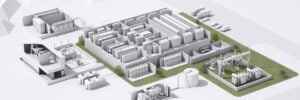
Rethinking Data Centers: Embracing Distributed Infrastructure for a Sustainable Future.

Introduction:
In today’s digital age, data centers have become the backbone of our interconnected world. However, their enormous size, high maintenance costs, and significant environmental impact have raised concerns about their long-term sustainability. In this blog, we delve into the complexities of data centers, provide in-depth analysis, share compelling case studies, and offer expert opinions to foster meaningful conversations around the future of data centers and the importance of sustainable infrastructure.
The Magnitude of Data Centers:
Did you know that an average data center now spans an area as large as a football field? These massive facilities can store mind-boggling amounts of data, often costing millions of dollars annually for maintenance alone. To power their operations, data centers require an astonishing 200 megawatts of electricity, contributing to the strain on our energy resources. Additionally, water consumption for cooling purposes can reach between 2 to 4 million gallons per year, putting further pressure on water supplies.
Environmental Concerns and the Digital Revolution in Africa:
As we confront pressing environmental challenges, it is essential to question the sustainability of building more data centers worldwide. With the ongoing digital revolution in Africa and the need for technological advancements, it is crucial to explore alternative solutions that minimize environmental impact. Simply replicating traditional data centers may not align with our goals of sustainability and resource conservation.

Case Study: Embracing Sustainable Practices
An example of this transformation in practice is seen with tech giants like Google and Microsoft, who are transitioning towards more sustainable data centers. Through the use of renewable energy, efficient cooling systems, and the recycling of server components, these organizations demonstrate that sustainability and high-performance computing can go hand-in-hand.
The Weather Factor and Distributed Infrastructure:
At ARED, we have carefully examined these issues and recognize the need for a paradigm shift. We firmly believe that distributed infrastructure offers a more sustainable path forward, particularly for small IT companies and other technical entities. By leveraging edge computing and decentralized systems, we can distribute computing resources closer to the point of use. This approach eliminates the need for resource-intensive data centers and maximizes efficiency.
Embracing the Potential of Distributed Infrastructure:
Distributed infrastructure not only reduces the ecological footprint associated with data centers but also offers numerous benefits. By moving computing power to the edge, businesses can enjoy lower latency, improved data security, and increased scalability. Moreover, this approach empowers local communities and enables the growth of small businesses, fostering economic development and innovation.
Building a Sustainable Future:
In the face of rapid technological advancements and environmental concerns, reimagining our approach to data centers is imperative. Providing in-depth analysis, sharing compelling case studies, and incorporating expert opinions can engage readers and foster meaningful conversations around the future of data centers and the importance of sustainable infrastructure. Together, let us prioritize sustainability, efficiency, and innovation, and pave the way towards a greener and more efficient digital landscape.
Join ARED on this transformative journey and be part of the movement towards a greener and more sustainable future.
FAQs
Q1: What is distributed infrastructure? A1: Distributed infrastructure is a model that decentralizes data storage and processing across various locations, reducing energy consumption and improving data processing efficiency.
Q2: How does distributed infrastructure contribute to sustainability? A2: Distributed infrastructure reduces energy consumption and associated CO2 emissions by decentralizing data storage and processing. It also supports e-waste management by extending the lifespan of server components.
Q3: How does distributed infrastructure improve data security? A3: By decentralizing data, distributed infrastructure reduces the risk of data loss and enhances security. If one node fails, the others can still function, ensuring data integrity and availability.
Conclusion
In conclusion, rethinking data centers and embracing distributed infrastructure is vital for a sustainable future. This approach addresses challenges like energy consumption, e-waste, and data security while ensuring efficiency and scalability for the digital age. It’s time to embrace the future of data centers – a future rooted in sustainability.


